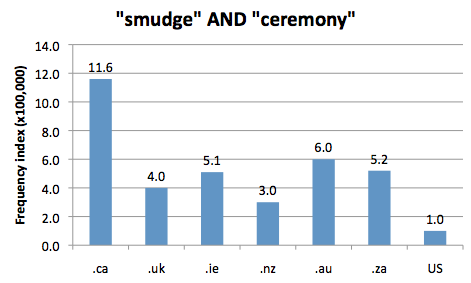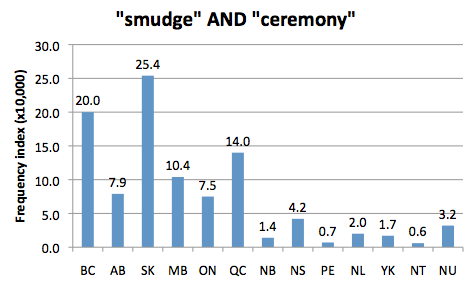DCHP-2
smudge smudging DCHP-2 (July 2016)
1a † n. — Fur trade, Outdoors, especially Western & Northern Canada
an intentionally smoky fire for dispelling mosquitoes and frost.
A smudge is most frequently referenced in regards to keeping mosquitoes at bay from people and animals alike.
The term smudge may function as a modifier preceding "fire" (see the 1891 quotation).See also: smudge (DCHP-1)
1b † n. & adj. — Fur trade, Outdoors, especially Western & Northern Canada
a can, pail, etc., often with a perforated bottom, used to build a smudge (see meaning 1a).
The term smudge may function as a modifier preceding "pot" (see the 1978 quotation).1c † n. — dated, Fur trade, Outdoors, especially Western & Northern Canada
the smoke that comes from a smudge (see meaning 1a).
2a v. — Aboriginal, especially Western Canada
to cleanse one's spirit by fanning ceremonial smoke over oneself or someone else.
Type: 4. Culturally Significant — Smudging is a cleansing ceremony traditional to many Aboriginal communities. The term smudge in the context of ceremonies is most frequent in Canada (see Chart 1). The term is most prevalent in Western Canada, yet the practice is country-wide, perhaps even continent-wide (see Chart 2, where Saskatchewan, British Columbia and Quebec show the highest frequencies within Canada).
The ritual involves burning one or several materials, and then fanning the smoke over oneself to clear the air, mind and spirit. Sweetgrass, cedar, sage and tobacco are most commonly used in First Nations' ceremonies (see Canadian Encyclopedia reference). While practices vary, smudging is considered to be a way of driving away negative energies (see Mullin et al. 2001). The cleansing ritual entails an initial "washing" of hands with smoke, followed by covering the entire head and body with smoke (see Gov't. of Manitoba reference).2b n. & adj. — Aboriginal, especially Western Canada
a spiritual cleansing ceremony using the smoke from a variety of materials.
Type: 4. Culturally Significant — The term smudge is used interchangeably with smudging. Both smudge and smudging are also used attributively as modifiers preceding "ceremony" (see the 2000, 2001 quotations). See the 2014 quotation for the particular herbs used.References:
- Canadian Encyclopedia "Indigenous Peoples: Uses of Plants" Accessed 11 Jul. 2016
- Gov't of Manitoba "Smudging Protocol and Guidelines" Accessed 24 Feb. 2015
- Mullin et al. (2001) "A Native Smudging Ceremony: A Young Native Patient in Palliative Care Teaches His Caregivers a Less Accessed 24 Feb. 2015
Images:

Chart 1: Internet Domain Search, 20 Apr. 2016
Chart 2: Regional Domain Search, 4 Mar. 2015